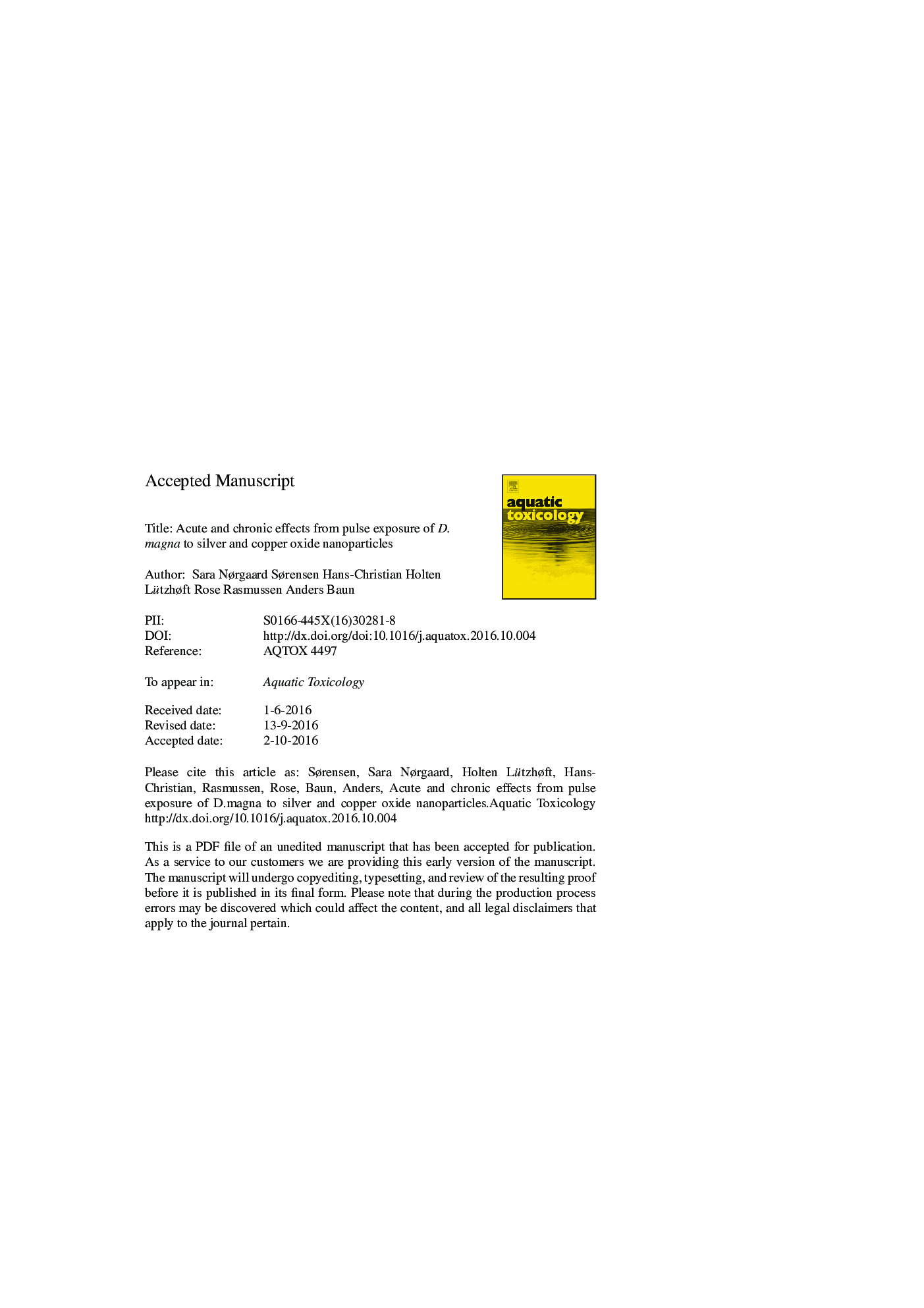| کد مقاله | کد نشریه | سال انتشار | مقاله انگلیسی | نسخه تمام متن |
|---|---|---|---|---|
| 6381843 | 1625925 | 2016 | 32 صفحه PDF | دانلود رایگان |
عنوان انگلیسی مقاله ISI
Acute and chronic effects from pulse exposure of D. magna to silver and copper oxide nanoparticles
دانلود مقاله + سفارش ترجمه
دانلود مقاله ISI انگلیسی
رایگان برای ایرانیان
کلمات کلیدی
موضوعات مرتبط
علوم زیستی و بیوفناوری
علوم کشاورزی و بیولوژیک
علوم آبزیان
پیش نمایش صفحه اول مقاله

چکیده انگلیسی
Aquatic toxicity testing of nanoparticles (NPs) is challenged by their dynamic behavior in test suspensions. The resulting difficulties in controlling and characterizing exposure concentrations are detrimental to the generation of concentration-response data needed for hazard identification of NPs. This study explores the applicability of short-term (1, 2 and 3Â h) pulse exposures as means to keep the exposure stable and at the same time disclose acute and chronic effects of AgNPs and CuONPs in D. magna. Dissolution, agglomeration and sedimentation were found to have less influence on exposure concentrations during 1-3Â h pulses than for 24-48Â h continuous exposures. For AgNPs, preparation of test suspensions in medium 24Â h before toxicity testing (aging) increased stability during the short-term pulses. In pulse tests, organisms were exposed to the test materials, AgNPs and CuONPs for 1, 2 and 3Â h, and afterwards transferred to clean medium and observed for 48Â h (post-exposure period) for acute effects and for 21 d for chronic effects. AgNO3 and CuCl2 were used as reference materials for dissolved silver and copper, respectively. For all test materials, a 3Â h pulse caused comparable immobility in D. magna (observed after 48Â h post-exposure) as 24Â h continuous exposure, as evidenced by overlapping 95% confidence intervals of EC50-values. In the 21 d post-exposure period, no trends in mortality or body length were identified. AgNP and AgNO3 pulses had no effect on the number of moltings, days to first live offspring or cumulated number of offspring, but the number of offspring increased for AgNPs (3Â h pulse only). In contrast, CuONP and CuCl2 pulses decreased the number of moltings and offspring, and for CuONPs the time to first live offspring was prolonged. After CuONP exposures, the offspring production decreased more with increasing concentrations than for CuCl2 exposures when taking the measured dissolved copper into account. This indicates a nanoparticle-specific effect for CuONPs, possibly related to the CuONPs accumulated in the gut of D. magna during the pulse exposure. Pulse exposure is an environmentally relevant exposure scenario for NPs, which for AgNPs and CuONPs enables more stable exposures and cause acute immobility of D. magna comparable to continuous 24Â h exposures. Pulse exposure is likely relevant and applicable for other toxic and dissolving metal NPs, but this requires further research.
ناشر
Database: Elsevier - ScienceDirect (ساینس دایرکت)
Journal: Aquatic Toxicology - Volume 180, November 2016, Pages 209-217
Journal: Aquatic Toxicology - Volume 180, November 2016, Pages 209-217
نویسندگان
Sara Nørgaard Sørensen, Hans-Christian Holten Lützhøft, Rose Rasmussen, Anders Baun,